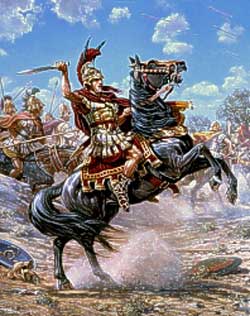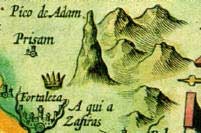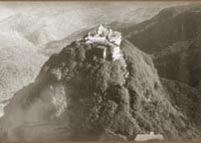Visit of Alexander the Great to the sacred mount of Sri Pada: Fact or Fiction?

|
Alexander the Great |
by S.S.M. Nanayakkara
Sri Pada or Adam's Peak as it was known to the early West was in the limelight from times before the recorded history of the island. Legends surrounding the sacred mount existed prior to the Christian era. It is axiomatic that worship of deities in high places is indulged in by mankind from times of remote antiquity. Indeed, high inaccessible places were held in awe and veneration from the time of man's primordial religion - worship of nature. The cult persisted in the pagan world up to the early Greek and Roman times and even later, thus Mt. Olympus in Greece was dedicated to the Greek pantheon.
Even to this day, Chomolungma (Tibetan for Goddess Mother of the World), a peak in the Himalayan range and several other peaks en route to Everest and Mt. Everest itself are held sacred by the Tibetans and Nepalese. It is recorded that Norkay Tensing and his sherpa clansmen who accompanied Edmund Hillary in his successful expedition to Mt. Everest in 1953, offered a sacrifice of food to the mountain goddess Chomolungma invoking her blessings for success of the expedition. Hillary himself buried a small crucifix given him by the leader, Colonel John Hunt. Tradition is hard to die!

|
 |
Alexander's visit
By the time that Macedon's illustrious son, Alexander the Great, Greek warrior king and empire builder, is believed to have visited Sri Pada (circa 324 B.C.), the peak was already held in veneration. After his subjugation of the Persian empire and the dependencies thereof, Alexander led his forces on to India beyond the Indus to the ancient city of Taxila. He was at last countered by Porus the Indian king and his cohorts of battle trained fighting elephants. These huge beasts were unfamiliar to the Greek cavalry to which they presented a forbidding and formidable obstacle. The terrified horses stampeded and started to scatter out of control in utter panic. On the representation of his generals, fearing mutiny by the army Alexander decided to come to terms with Porus.
After his skirmish with the Indian king, the restless Alexander decided to detour the southwest coast of India and explore further south where he had heard of the fabulous isle of Sri Lanka known to the early Greeks as ‘Taprobane'. Here reports of the sacred mount of Sri Pada, then dedicated to the Hindu deity Saman and known as ‘Samanthakuty', attracted his attention. The peak with its proud pinnacle commanding an enchanting prospect was too much of an attraction for the pleasure-bent Alexander to resist.
Ancient artefacts
Ashraff, the 15th century Persian poet and chronicler, describes this odyssey of Alexander to Sri Pada in his work ‘Zaffer Namah Skendari'. After landing in the island and indulging himself and his retinue in orgies and revelry he explores the wonders of the island. Here Alexander is known to have sought the assistance of the philosopher Bolinas, a celebrated Greek occultist and magician, to climb the sacred peak then supposed to be zealously guarded by various deities.
Among the artefacts devised to ascend the almost inaccessible peak were massive iron chains affixed to stanchions of the same metal secured to the bare rock face. The chains were secured to the stanchions with rivets of iron and bronze. Remains of these artefacts still exist. Early pilgrims to the peak sought the assistance of these chains to hoist themselves up to the summit.
The belief that Alexander visited Sri Pada existed before Ashraff. Ibn Batuta the romantic 14th century pilgrim traveller from Tangiers in Morocco who sojourned in the island visiting the sacred mount, refers to a grotto at the foot of the peak with the name ‘Iskander' inscribed on it. This ‘Iskander' and ‘Skendari' of Ashraff are identical, both names refer to none other than the celebrated Alexander the Great himself. Notes Batuta in his memoirs:
Apart from scanty and much belated Arab sources, history is strangely silent for over seventeen centuries on the visit of Alexander to the island and his journey to Sri Pada. Neither the Great Dynastic Chronicle ‘Mahawamsa' or any other historical record of significance refer to it. Alexander's exploits were centered mainly in and around Persia and the Persian empire, the legends and folklore of the early Persians were, as a matter of course, handed over to their Arab posterity.
Commenting on the ancient artefacts on Sri Pada, the Englishman Robert Percival, who served with the British garrison in Colombo in the early nineteenth century, notes:
Courtesy: The Island Saturday Magazine (Colombo) of 4 January 2003
|
Ashraff, the 15th century poet describes the odyssey of Alexander the great to Sri Pada in his 'Zaffer Namah Skendari'. After landing in the Island and indulging himself and his retinue in orgies and revelry he explores the wonders of the Island. Here Alexander is known to have sought the assistance of the Philosopher Bolinas, a celebrated Greek occultist and magician, to climb the Sacred peak, then supposed to be zealously guarded by various deities. The belief that
Alexander visited Sri Pada existed before Ashraff. Ibn
Batuta, the romantic 14th century Arab pilgrim
traveller from Tangiers in Morocco who
sojourned in the Island visiting the Sacred Mount, refers to
a grotto at the foot of the peak with the word "Iskander"
inscribed on it. This 'Iskander' and 'Skendari' of Ashraff
are identical; both names refer to none other than the
celebrated Alexander the Great himself. Notes Batuta in his
memoirs: "The ancients have cut steps of a sort on the
vertical rock face, to these steps are fixed iron stanchions
with suspended chains to enable pilgrims clamber up to the
top with ease and minimum risk." |